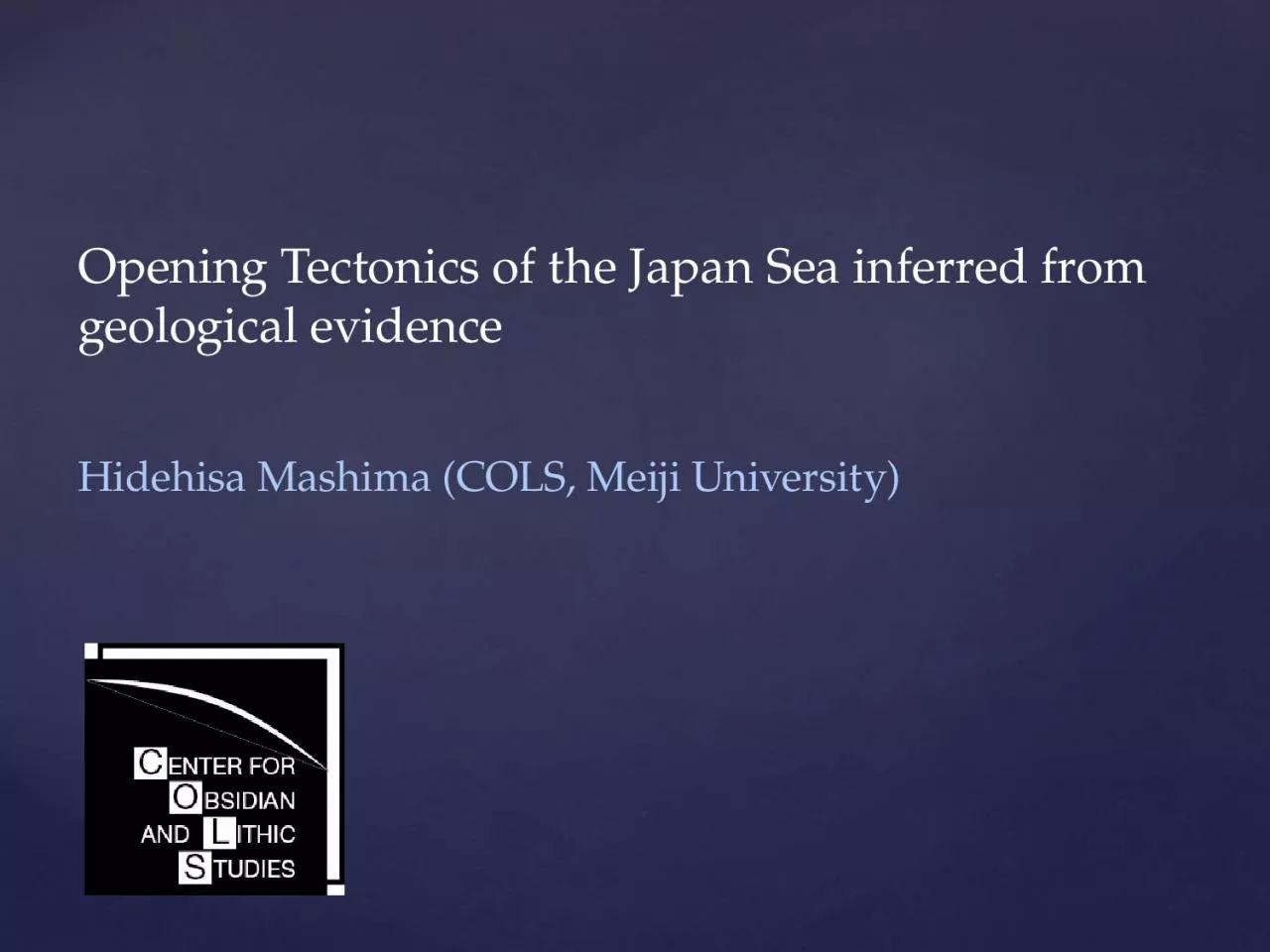

evidence Hidehisa Mashima COLS Meiji University rans Let us devote ourselves to pursuit of the ultimate truth about nature by studying what we can find around us Of course we must respect and value existing theories but it is important not to place too much confidence in them We sh ID: 1022864
Download Presentation The PPT/PDF document "Opening Tectonics of the Japan Sea infe..." is the property of its rightful owner. Permission is granted to download and print the materials on this web site for personal, non-commercial use only, and to display it on your personal computer provided you do not modify the materials and that you retain all copyright notices contained in the materials. By downloading content from our website, you accept the terms of this agreement.
1. Opening Tectonics of the Japan Sea inferred from geological evidenceHidehisa Mashima (COLS, Meiji University)
2. rans: "Let us devote ourselves to pursuit of the ultimate truth about nature by studying what we can find around us. Of course we must respect and value existing theories, but it is important not to place too much confidence in them. We should be free from authority and convention and modest before Mother Nature. We should investigate books and articles written by famed scholars. The most critical thing, however, is to observe nature with unbiased eyes, experiment with our own hands, honor fresh ideas gained from natural materials, and nurture them in a lively environment."
3. ExampleRadiometric isotopes only suggest that geochemical endmembers were stored as solids in the mantle for Gys.Radiometric isotopes don’t have information of depth in mantleCan geochemistry prove deep recycling?
4. Accretion of oceanic materials in subduction zones stores geochemical endmembers in continental lithosphereMoore et al. (2001)
5. Helium isotopesPlume modelHigh 3He/4He high 3He sourceUndegassed lower mantleAlternative modelHigh 3He/4Helow 4He [U-Th poor] source Olivine –rich refractory mantle
6. Two distinctive models for opening tectonics of the Japan Sea
7. Plume-like active mantle upwelling?Activities of high magnesium andesites and fore-arc felsic volcanic rocks at 14 Ma after the Japan Sea opening.
8. The DDO model based on the incomplete logic of paleomagnetismDDO model advocators assumed coherent rotation of SW Japan to explain paleomagnetic declinations.But, rotations of faulted blocks can also explain paleomagnetic declinationsWhy didn’t they examine block rotation?
9. Distributions of Precambrian and Paleozoic blocks
10. Reconstruction of SW Japan is obtained from Otofuji and Matsuda (1983) DDOM assumes that the Unazuki Belt would be exdension of the Okchon Belt.But no Precambrian unit corresponding to the Yongnam at the south of the Unazuki Belt in JapanHorizontal rotation angle would be overestimated
11.
12. 桜井・永野 (1976)
13. 対馬五島断層の北方延長(Ulleung Fault)Yoon et al. (2014)
14. 野母海嶺
15.
16. 北部九州と韓半島の地質学的関係SE KoreaSefuri mountains北部九州は韓半島に対して水平回転していない
17. Western Honshu would not have rotated with respect to Korea
18.
19.
20. Sinistral dome & basin structure(Matsui et al., 1989)
21. Escalation of strike-slip movement at 20 Ma(Nagahama, 1969; Sakai et al., 1990)
22. Rapid sedimentation of the Nojima Group between 18 and 15 MaKomatsubara et al. (2014)
23. Rapid sedimentation of the Taishu Group between 18 and 16 Ma17.9 Ma15.9 MaNinomiya et al. (2014)
24. Rapid sedimentation at NW margin of the Tsushima basin between 20 and 15 MaLee & Kim (2002)
25.
26. Japan trench would have been the eastern master fault
27. Subsidence of off Joban BasinObtained from Iwata et al. (2002)
28. Dextral deformation of HokkaidoUplift between 20 and 15 Ma(Ono, 2002) Ueda et al. (2001)
29. Kita et al. (2010)After 2003 Tokachi EarthquakeAfter 2011 Tohoku EarthquakeFuruya (2016)
30. Pull-apart opening of the Japan Sea
31. Paleomagnetic declinations and plate coupling Palaeomagnetic declinations are obtained from Ishikawa (1997)
32. Takachiho Orogeny (20-15Ma) uplift of the Shimanto Belt
33. Modern example
34. Pull-apart opening and paleomagnetic delcinations
35. Sato et al. (2018)Newly formed oceanic crust (Sato et al., 2018) or stretching and underplating ?
36. Southward mantle flow?
37. The double door model is inconsistent with lines of geological evidencePull-apart model is indicated by lines of geological evidenceThe Thushima-Goto fault and the Japan Trench would have been master faults of the pull-apart openingPaleomagnetic declinations could have been caused by strong mechanical coupling between the plates. Conclusions